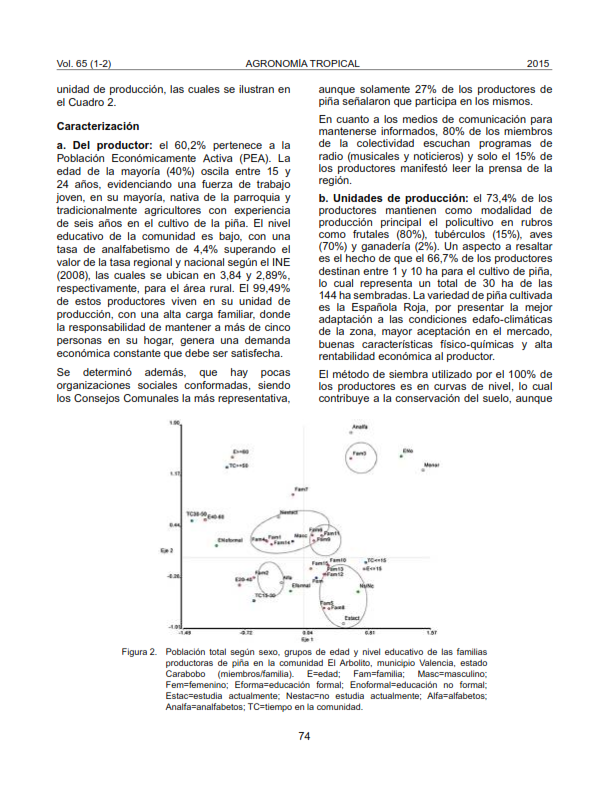Characterization of growers and the marketing of pineapple in the rural community El Arbolito, Valencia municipality, Carabobo state (2007-2009)
Abstract
Pineapple (Ananas comosus var. comosus) is commonly cultivated by communities poor agronomic management with technological level, showing low yields per unit area and lower quality demanded by the market. A study was conducted in the community El Arbolito, Valencia municipality, Carabobo state with the participation of 15 farming families pineapple existing in the area, aiming to characterize the marketing in the local chain of this product during the years 2007-2009. There search was a descriptive-participative type. Field observations and interviews to obtain collective information about technical, organizational and marketing were made. In addition, a survey to 100% of the population was applied. The physical characteristics of the fruits were evaluated, respecting the classification made by producers in the area as large, medium and small. Once performed the statistical analysis, the results show that 76% of households own plots between 3 and 20 ha. 73.3% of producers sell to intermediaries, truck or wholesalers and do not act directly in the marketing process. The result of physical quality analysis indicated that only two farms, the fruits exceed 1.8 kg. However, these are acceptable in the market but do not obey the classification by type, existing in the national quality standard for the product. Producers recognize the poor organization and participation in the process.
Downloads
References
• Avilán, L., F. Leal y D. Bautista. 1992. Capítulo VIII Bromeliaceae. Tomo 1. En: Manual de Fruticultura. Editorial América. 2da. Edición. Caracas, Venezuela. pp. 502-578
• Ballestrini, M. 2004. Cómo se elabora el proyecto de investigación. Servicio Editorial BL, Consultores Asociados. 6ta. Edición. Caracas, Venezuela. 230 p.
• COPLANARH (Comisión del Plan Nacional de Aprovechamiento de los Recursos Hidráulicos). 1975 Inventario Nacional de Tierras Región Centro Costera. Atlas MAC- CENIAP. Caracas. 42 p.
• COVENIN (Comisión Venezolana de Normas Industriales). 1983. 2075-83. Piña.
• Figuera, S.2003. Análisis de correspondencias. 33 p. Disponible en línea: http://bit.ly/2TFBh7q [Feb. 08, 2015].
• Fred, D. 1997. Conceptos de administración estratégica. 5ta. Edición. Editorial McGraw Hill. 382 p.
• Grahame, D. 2005. Comercialización de productos agrícolas. Guía de extensión en comercialización. Organización de las Naciones Unidad para la Agricultura y la Alimentación. Roma. pp. 151.
• Guerra, G. 1998. Manual de administración de empresas agropecuarias. 3ra. Edición. Instituto Interamericano de Cooperación para la Agricultura (IICA) GTZ, El Salvador. 208 p.
• Greenacre, M. 1994. Multiple and Joint Correspondence Analysis. En: Greenacre, M. J. y Blasius, J. (Ed.). Correspondence Analysis in the Social Sciences, London: Academic Press. 374 p.
• INE (Instituto Nacional de Estadística). 2008. Resumen estadístico: Censo Poblacional, 2000. Caracas. Venezuela. Disponible en línea: http://bit.ly/2TC4C2i [Jul. 07, 2009].
• InfoStat. 2008. Versión 1.1. Grupo InfoStat, FCA, Universidad Nacional de Córdoba, Argentina. 276 p.
• MPPCTII (Ministerio para el Poder Popular de Ciencia,Tecnología e Industrias Intermedias) 2007. Estudio del proceso productivo de la piña en la comunidad El Arbolito, parroquia Negro Primero, municipio Valencia, estado Carabobo. Oficina de Gestión Social del Conocimiento. FUNDACITE-Carabobo. 44 p.
• Montilla de Bravo I., S. Fernández, D. Alcalá de Marcano y M. Gallardo. 1997. El Cultivo de la Piña en Venezuela (Maracay), Fondo Nacional de Investigaciones Agropecuarias. Centro de Investigaciones Agropecuarias del estado Lara. 155 p.
• Moreno, A. y L. Huanca. 2001. El análisis de correspondencias múltiples aplicado a la identificación de características por edades de los niños y jóvenes trabajadores del distrito de Comas. Disponible en línea: http://bit.ly/3cSzjbp. [Jul. 16, 2014].
• Pérez, J. and P. Garbati. 2004. Evaluation of different soil preparation techniques for pineapple production. Pineapple News. 10:8-9.
• Pineda, A., T. Vargas, M. Escala y E. García. 2012. Organogénesis in vitro en piña Española Roja y morfoanatomía de las plantas obtenidas en el proceso. Bioagro.24:175-186.
• Rincón N., E. Segovia, G. Aguilera, A. López, E. Zavarce y M. Leal. 2004. Los pequeños productores y su participación en el proceso de comercialización agrícola. Rev. Fac. Agron., Universidad del Zulia (LUZ). 21:172-185.
• Sepúlveda, S., A. Rodríguez, R. Echeverri y M. Portilla. 2003. Enfoque territorial de Desarrollo Rural. Instituto Interamericano de Cooperación para la Agricultura (IICA). San José de Costa Rica. 180 p.
• Shepherd, A. y J. Ilboudo. 1995. Guía práctica de comercialización y la forma de calcularlos. Dirección de servicios agrícolas de la FAO. Roma. 25 p.





